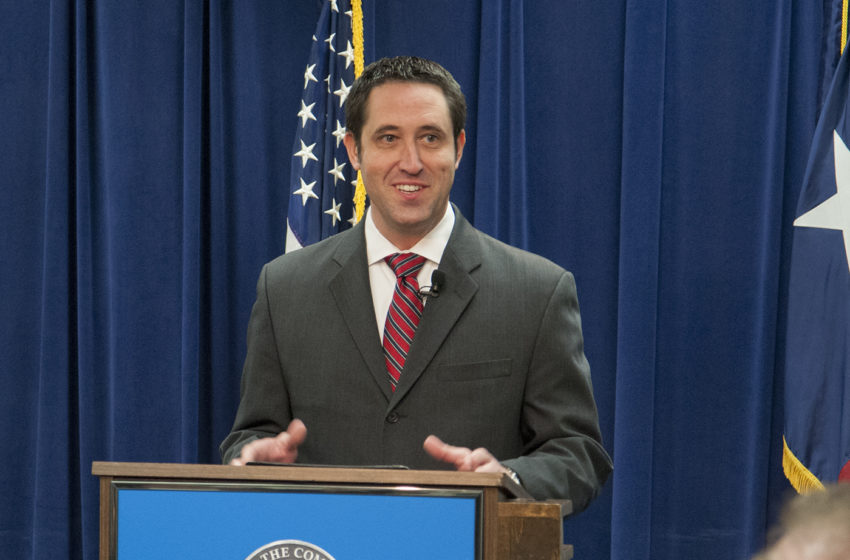Texas Comptroller Glenn Hegar on Texas’ Firm Economic Foundation

In early April, long before we had all the data in on the economic impact of COVID-19, Texas Comptroller of Public Accounts Glenn Hegar stated unequivocally that Texas was in a recession. At the time, many others were shying away from the word. Hegar, on the other hand, warned that the only question was how deep and long the recession would be.
But don’t take the overseer of the Texas treasury as a doom-and-gloom type. While acknowledging the “double headwinds” of the pandemic and a slump in oil and gas, Hegar’s belief in a Texas recession was tempered by a steady optimism in the state’s economic underpinnings. In this conversation, the comptroller discusses the constitutional duties inherent in his role, the pandemic’s effect on Texas’ tax revenue and budget, and his belief that Texas can and will recover.
Texas CEO: Let’s start with the basics. Can you explain what the comptroller actually does?
Hegar: Sure. In my office, we have 3,000 employees in roughly 26 different divisions, with a wide range of responsibilities and duties. I typically describe my job by listing my three constitutional responsibilities.
The first responsibility is ensuring that the 14 million payments made by the State of Texas are issued on time. That covers all the various state agencies, and it’s roughly a $126 billion budget, all flowing through the state treasury. It’s my responsibility to oversee that, including all payments to employees, vendors, and other parties.
Second, we handle tax collections on behalf of the state. This is a little unique. In most states, you have two different divisions, one doing the expense side and another doing the revenue collection. In Texas, we like to do things different, so our controller’s office handles tax-revenue collection as well.
My third responsibility is revenue forecasting. On the second Monday in January on odd years, one day before the legislative session starts, I have a constitutional responsibility to tell the legislature how much money we think will come into the state treasury. That allows them to set the two-year state budget that will start later in September of that year.
The comptroller’s office has a wide range of other responsibilities, but those are the essential functions of the agency, our constitutional duties.
Texas CEO: How have things changed regarding that first responsibility in recent months? Have you been expected to cut back on expenses?
Hegar: We were watching COVID-19 closely before it was officially a pandemic. At that same time, Saudi Arabia and Russia couldn’t make an agreement for OPEC cuts, when Saudi increased its production. Given these two events, it seemed pretty evident that Texas was going to have some type contraction, either regionally or statewide. We didn’t know that we were moving into social distancing, but pretty quickly I started advocating to leadership—the governor, lieutenant governor, and speaker—that state agencies reduce their expenditures. While I don’t have the authority to tell state agencies to reduce expenditures, advocating to leadership is one tool in our toolbox. And in speeches and on calls with members of the state house and senate, I said we were likely going into a recession, though we didn’t know how deep or long it would be.
We also, of course, looked to reduce our expenses in our own agency. I instructed my staff that we were going to do a strategic freeze on hires, freeze pay increases, and review all our IT projects. I knew from past experience in the legislature that it’s better to start early and move quickly in reevaluating your expenditures in these situations.
Texas CEO: At the federal level, we talk about “discretionary spending,” or the part of the budget that is optional and set by appropriations bills, as opposed to mandatory spending. Are there categories of expenses like that at the state level?
Hegar: There are certain dollars that are discretionary, and state agencies can reduce their budget. For example, we looked at expenditures our of Texas’s economic stabilization fund, or “rainy day” fund. Fortunately, we have a healthy balance in that fund, but we wanted to see whether we could retain some of those funds that the legislature made large appropriations on last session. Some of those were more discretionary expenses, things like [Hurricane] Harvey–related repairs.
We do have non-discretionary spending. When looking at what we could cut, we had to automatically exclude Medicaid, which is an entitlement, and public education, which is a constitutional right. Historically those two are “held harmless” [guaranteed to receive previously allocated funding]. After those, you have roughly a third of the state expenses left and for most agencies, those costs are people. So you can, like we did, freeze hiring and pay increases. But the question becomes, how do you reduce your expenditures without having to let people go?
Texas CEO: Right, most businesses deal with that same situation. Turning to that second responsibility of tax collections, how were we doing on bringing in revenue back in January and February? Were we tracking normally, or had you already seen an indication that things were slowing down?
Hegar: Based on the revenue estimate I’d updated for the legislature last fall, we were tracking slightly ahead in revenue collections. The treasury was doing well. Strong job gains had been continuing in the state of Texas—in February, we added about 50,000 jobs. We had noticed some mild weakness in sales tax collections from the mining sector—oil and gas. In that sector, we knew that for the next two years, we’d have to rework a significant amount of financing, as private equity and banks didn’t want to lend as much as in the past. But oil and gas revenues from the production side continued to be healthy—maintaining if not slightly growing.
The question for the Texas economy at that point was whether the slowing in the mining sector would have a ripple effect into manufacturing or other sectors. We didn’t know were going to have the double headwinds of lower prices and production in the mining sector and also the COVID-19 pandemic. But prior to the two events in March, the economy was right on pace. Texas had been outpacing the national average economically.

Texas CEO: You’ve released some updates on the tax revenue coming into the state since COVID hit. How significantly have tax revenues been down?
Hegar: Sales taxes are the biggest portion of the Texas state budget and accounts for 57 percent of all state tax collections. All revenue streams are important, but for the State of Texas, sales tax is the one that significantly determines the health of the state budget. That’s why you see a focus on it. When we released numbers at the end of April, I wanted to be very clear that these only reflected part of the slowdown. That’s because we essentially have a one-month lag in reporting, so those numbers reflected revenue for March, when most businesses continued to operate for the first three weeks of the month.
When we released new numbers on June 1, those reflected April sales-tax collections, and we did see much more of an impact there. Sales tax was down 13.2 percent compared to May of 2019. That’s the steepest year-over-year decline since January of 2010. There were significant drops in other revenue streams. Motor vehicle sales and rental taxes were down 38 percent, which was a little improvement compared to the numbers released in April, but not significantly. Motor fuels taxes were down 30 percent, and that was our deepest decline since 1989. Natural gas and oil production were down significantly, roughly 75 percent each. And our revenue from hotel occupancy tax was down 86 percent, the steepest drop we’ve had on record since 1982. Hotel occupancy taxes are not a large portion of the state budget by percentage, but it shows you the significant impact in that industry.
Alcoholic beverage taxes were also down 76 percent, the steepest drop since 1980. A large portion of that revenue comes from mixed beverages, so having restaurants and bars closed through April had a big impact, even though people could still go to the liquor store or the grocery store to buy wine and beer.
Texas CEO: You said that this was the biggest drop in sales tax collections since 2010, even though the recession began in 2008. Why was the revenue drop so significant at that point?
Hegar: The great financial crisis of 2008 had an immediate impact in several types of taxes—for example, car sales. But overall, the ripple effect took a lot longer. There was about a six-month delay before we started seeing an impact in sales tax receipts, and then it actually got worse several months later, in Fiscal 2010.
We did look back at those historical events even in early March of this year, but once it became clear that this was a pandemic, we started saying that this would look different. There wasn’t going to be a long lag in the sales-tax decline this time, since so many industry sectors were literally shut down. One really striking example is that previously we had something like 2.3 million people passing through our airports in the United States every day, but at the low point of the shutdown, we only had something like 90,000 a day. That kind of remarkable closing down told us that we’d see the impact on sales-tax collections immediately. No six-month lag, with another nine months before we got to the bottom of the trough, as we had after the 2008 recession.
Texas CEO: Are you seeing a significant increase in businesses not filing their taxes, or not being able to file their taxes?
Hegar: We had a lot of discussions about that, especially with the restaurant industry. Nobody writes a business plan that includes shutting down for several days, much less several weeks. No one does stress-tests like that. Under a disaster declaration, I can give a 90-day referral on payment of those taxes. The disaster declaration came down on March 13, but we asked businesses to file the return if they could, because they are holding those taxpayer funds in trust for the State of Texas. If they can’t, then we work with them on a case-by-case basis. We’ve been working down the list of businesses who have not filed to remind them and to let them know that if they’re having trouble, we can work with them on a payment agreement.
For major companies that are not having cash flow issues, we generally do not allow for postponements. We don’t want larger, solvent businesses using the state as a float, and in essence asking for short-term loans. But we are sensitive to those businesses we do need to work with. We’ve obviously had an uptick in those situations compared to January and February.
Texas CEO: Let’s move to the hundred-billion-dollar question. What do you think your new budget estimate is going to look like? You have a while before you have to make a prediction, but do you think this is likely to have a single-digit impact on the budget? Double digit?
Hegar: The current two-year budget cycle ends August of next year, so we have roughly 14 months left on this budget. If you look at the current budget cycle, hopefully the impact is in the single digits, yes. It comes down to when we see an economic recovery. Of course, we don’t know what’s going to happen in the fall. Is the economy going to continue to be shut down to some degree? And as I remind people, Texas accounts for 19 percent of the entire nation’s exports, so we’re tied to what happens in the global economy. Supply-chain issues in other countries have an impact here. When the next legislative session begins next January, when they will put the next two-year budget together, we will hopefully know more about how slowly or quickly we’ll see a recovery. COVID-19 and the shutdowns will have an impact on the budget of course, but we don’t yet know whether that’s a double-digit or single-digit number.
We need a few more months’ data at this point. Some other states that are supposed to have already put together their budgets for the new fiscal year have asked for continuing resolutions so the state can stay funded for the next few months while they look at the new data to make a better prediction. We’re about at the point where we can see where the trend lies.
Texas CEO: What have we not talked about that you’d like to communicate to the CEOs of Texas?
Hegar: While I do think that, yes, the next legislative session is going to be rough, Texas’ economic foundation is strong. Listening to some of the calls with treasurers from across the nation—I can tell you that we’re in a lot better shape than some of them are. We’re going to be able to come out of this, I hope, a little quicker than some of the other states, even though we face the two strong headwinds of the pandemic and the downturn in oil. I can tell you that it was a hell of a lot more fun doing my job in January and February. I know most CEOs in Texas feel the same way. But there is reason to be hopeful.
Texas entered this with a stronger economic foundation than most other states and nations. We’re blessed in that respect. From a price standpoint, Texas is more affordable than most other states, as we know. Our population is growing. We have a younger workforce than most other states, and there’s a commitment from leadership to continue to do what we need to do in order to continue building up a strong workforce—through public education, higher education, and other programs. I’m having a lot of discussions with policymakers about what the state needs to focus on in this shifting work environment to ensure that businesses can continue to thrive here in Texas. Ultimately, we’re all working to get Texas back to fully doing business, and to make Texas even more competitive than it has been in the past.





